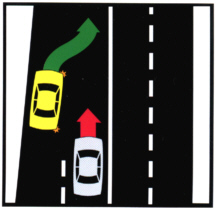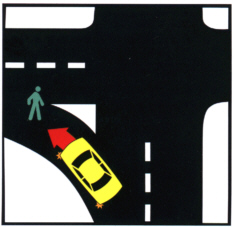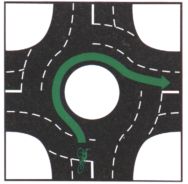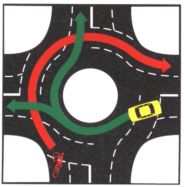

Look for this type of flyer at VicRoads offices Motorcyclists Bicyclists Pedestrians
On 1 December 1999 the Victorian State Government implemented a new set of national road laws.
They are designed to reduce confusion and improve road safety regardless of where you drive in Australia. In particular the new road rules will make interstate driving hassle free for Victorians and the thousands of international tourists who visit our State's world class tourist destinations every year.
While there has been some important changes designed to improve safety and consistency, many other changes to the existing rules have been made so as to simplify the laws and make them easier to learn. In short the changes to Victoria's road laws are in every sense rules you can live with.
The major changes
The changes to Victoria's road rules will have
a direct impact on many important areas. For example the changes affect
important rules like:
Most rules will stay the same
While some important road rules will change,
many of Victoria's rules have been adopted as national rules and will stay
the same. This means that key rules will be familiar to local drivers.
The basics still apply
Remember, despite the changes, the basic road
rules still apply:
You must obey the speed limit
You must wear your seat belt
You must not cross double-lines
You must abide by traffic signs, lights and
road markings.
Some important new rules explained
Keeping to the left on a multi-lane road
Drivers must not drive in the right lane on multi-lane roads with a speed limit over 80 km/h, unless;
Merging when two lanes become one
Where two lanes merge, drivers crossing the line
will be changing lanes and must give way. If there is no line drivers must
take turns.

Giving way at roundabouts
Pedestrians are required to give way to motorists
entering or leaving a roundabout.

Wheeled toys, skate-boards and in-line skates
on footpaths
People on skateboards, in-line skates and wheeled
toys are required to give way to pedestrians on footpaths.
Crossing a rail or tram level crossing by pedestrians
Pedestrians are required to use the pedestrian
crossing facility if there is one within 20 metres of the railway crossing.
Stopping and parking
Riding your bike

Give way to pedestrians
when crossing a slip lane
Drivers need to be aware that they must always
give way to a pedestrian when crossing a slip lane.

Use of hazard warning lights
Motorists can now use their hazard warning lights
if their vehicle is moving slowly, in fog or similar circumstances. Drivers
should take note that a flashing orange light may be on a moving vehicle,
and they may reach it more quickly that expected.
Walking on the side of the road
Motorists need to be aware that pedestrians are
no longer restricted to walking on the side of the road facing on-coming
traffic. Motorists are likely to encounter pedestrians walking on either
side of the road.
To find out more you can purchase a copy of the Victorian Traffic Handbook at any newsagent or any VicRoads Registration and Licensing Office. As well you can check out their web site at http://www.vicroads.vic.gov.au or call out their toll free number on 13 11 71
Introduction
Like all other road users, motorcyclists are required to comply with the road traffic laws.
A number of laws affecting motorcyclists were changed when the Australian Road Rules were implemented in Victoria on 1 December 1999.
This information outlines the significant changes to these traffic laws and reminds motorcyclists of other traffic laws that are important.
The New rules
Position on the Road
Motorcyclists are no longer required to ride
as far left as practicable on a road without marked lines.
Motorcyclists must not ride more than two abreast on a road without marked lanes. On a road with marked lanes, motorcyclists must not ride more than two abreast in a lane.
When motorcyclists are riding two abreast, the two motorcycles must not be more than 1.5 metres apart.
Passengers
A sidecar passenger must wear a motorcycle helmet.
A pillion passenger may only be carried on a motorcycle designed for this purpose and must have both feet on the footrests provided.
Hand Signals
If during a trip, a motorcycle is found to have
a faulty brake light, the rider may use either arm for hand signals to
indicate stopping or suddenly slowing. A faulty brake light should be repaired
before the next trip.
Keeping Left on a Multi-lane
Road
Motorcycles and other vehicles must not travel
in the right lane of a multi-lane road with a speed limit over 80km/h,
or where there is a Keep Left Unless Overtaking sign, except when overtaking,
turning right or making a U-turn. This rule does not apply if the traffic
is congested, or if the driver is avoiding an obstruction.
Overtaking on the Left
A driver or motorcyclist must not overtake on
the left of a moving or stationary vehicle in the same lane, or on a road
without marked lanes.
Remember the Basics Still Apply
Transit Lanes
Motorcycles may travel in transit lanes, such
as the Eastern Freeway transit lane.
Motorcycle Parking
Motorcycles may be parked on footpaths, provided
they do not inconvenience, obstruct, hinder or prevent the free passage
of any pedestrian or other vehicle.
Motorcycles may be angle parked where other vehicles
must be parallel parked.
Introduction
Like all other road users, cyclists are required
to comply with the road traffic laws.
Under Victorian law, bicycles are defined as vehicles and as such, cyclists are required to comply with many of the same traffic laws as motorists. They are also required to obey laws that apply just to cyclists.
A number of laws affecting cyclists were changed
when the Australian Road rules were implemented in Victoria on 1 Dec 1999.
This information outlines the significant changes
and reminds cyclists of other road rules that are important.
| A bicycle is a vehicle that is built to be
propelled by human power through a belt, chain or gears. For the purposes of the road rules, pedicabs, scooters, penny farthings, tricycles and unicycles are all defined as bicycles, even if they are powered by a motor with a power output of up to 200 watts. Wheelchairs, skateboards, in-line skates
|
Cyclists are exempt from this requirement and may enter the roundabout and complete their turn, from either the left lane or the right lane.
A cyclist who chooses to make the right turn from
the left lane, is effectively changing lanes each time they ride past an
exit. As such, they must give way to any vehicle that is crossing their
path to leave the roundabout.
 |
Cyclists may turn right
from the right lane of two-lane roundabouts |
 |
Cyclists may also turn right
from the left lane of two-lane roundabouts, but must give way to vehicles that cross their path. |
Cycling on Freeways
Cycling is permitted in the emergency stopping
lane of freeways, unless a sign has been erected to prohibit cycling.
On most urban freeways signs are erected prohibiting cycling.
Towing Children in Bicycle Trailers
Under the new regulations, a person now may be
legally towed in a bicycle trailer, provided:
An approved bicycle helmet must be worn at all times when cycling.
Light and reflectors must be fitted to bicycles for night riding. Rear light must be red and front lights must be white. Both lights must be visible at up to 200 metres and both can be flashing.
When riding on shared footways cyclists must keep to the left and give way to pedestrians.
Hook turns may be undertaken at any intersection, unless a sign has been erected to prohibit a hook turn.
Cyclists must ride in bicycle lanes when they are marked on the roads.
Riding two abreast is permitted, however cyclists must ride no more than 1.5 metres apart.
Hand signals must be used when turning right, but are not required when turning left, or stopping.
An efficient brake and a warning device, such as a bell, must be fitted to a bicycle before it can be ridden.
Overtaking on the left of a vehicle is permitted unless the vehicle being overtaken is turning left, or indicating to turn left.
Riding to the left of a white edge line is permitted by cyclists.
Riding closer than two metres behind another vehicle is not permitted.
Holding onto a moving vehicle while riding a bicycle is not permitted.
Leading an animal while riding a bicycle is not permitted.
Bicycles may be parked on footpaths and
nature strips.
Introduction
Like all other road users, pedestrians are required
to comply with the road traffic laws.
Under Victorian law, a pedestrian is defined as including a person in a wheelchair and a person on a wheeled recreational device or wheeled toy
A number of laws affecting pedestrians were changed
when the Australian Road rules were implemented in Victoria on 1 Dec 1999.
This information outlines the significant changes
and reminds pedestrians of other road rules that are important.
Definitions
The new traffic laws include the following definitions:
Wheelchair
A wheelchair is a chair mounted on two or more
wheels that is built to transport a person who is unable to walk or has
difficulty in walking. A wheelchair does not however, include a pram, stroller
or trolley. A wheelchair can have a motor attached provided it does not
allow the wheelchair to travel at over 10km/h on level ground.
Wheeled recreational device
A wheeled recreational device is one which is
built to transport a person, propelled by human power or gravity and ordinarily
used for recreation or play. A wheeled recreational device includes in-line
skates, roller-skates, a skateboard or similar wheeled device, but does
not include a golf buggy, pram, stroller, bicycle, wheelchair or wheeled
toy.
Wheeled toy
A wheeled toy is a child's pedal car, scooter
or tricycle or a similar toy, but only when it is used by a child who is
under twelve years old. A bicycle or scooter can have an auxiliary motor
up to 200 watts. If the motor exceeds 200 watts the device is a motor vehicle
and can not be used on the road unless registered.
The New Rules for Pedestrians
No pedestrians signs
A pedestrian must not travel past a NO PEDESTRIANS
sign or a NO PEDESTRIANS BEYOND THIS POINT sign.
Crossing at an intersection
A driver turning at an intersection must give
way to any pedestrian crossing the road they are turning into. At
a roundabout a driver is not required to give way to a pedestrian when
entering or leaving the roundabout.
Crossing a slip lane
A driver turning left in a
slip lane (an area of road for vehicles turning left that is separated
from other parts of the road by a painted island or traffic island) must
give way to any pedestrian who is crossing the slip lane. However, a pedestrian
should be careful to ensure that an approaching vehicle is going to stop
before stepping onto the slip lane.
Accessing a tram
A driver behind a tram when the tram stops, must
stop and give way to any pedestrian who is crossing between the tram and
the far left side of the road. A driver is not required to stop at a tram
safety zone. A pedestrian leaving a safety zone should cross the road only
when it is safe to do so.
Crossing a railway line or tram tracks at a
level crossing
When crossing a railway line or tram tracks at a level crossing, a
pedestrian must use a pedestrian crossing facility if there is one provided
within twenty metres of the level crossing.
Restrictions on the use of a wheeled recreational device or a wheeled
toy on certain roads and paths.
A person must not travel on a wheeled recreational device or wheeled
toy on:
Remember the Basics Still Apply
In addition to the new road rules, many road rules for pedestrians remain the same. The following outlines some of the key road rules that are important for pedestrians.
Crossing the road
A pedestrian crossing a road must travel by the shortest safe route
and must not stay on the road any longer than is necessary to complete
the crossing.
Drivers are required to stop at a signalised pedestrian crossing when facing a red light, to give way to pedestrians on a pedestrian crossing and must not drive onto a children's crossing if there is a pedestrian on the crossing.
Signalised pedestrian lights or intersection traffic lights
At pedestrian lights and at an intersection with traffic lights, pedestrians
must only start to cross the road when the pedestrian light ("Walk" or
pedestrian symbol) is green. If a pedestrian
is on a crossing when the green light ("Walk" or pedestrian symbol) changes
to flashing red, the pedestrian should continue to cross the road promptly.
However, a pedestrian must not commence crossing a road when a
red light is operating.
Getting on a tram
A pedestrian waiting for a tram must not move onto the road until the
tram has stopped. When getting on or off a tram, a pedestrian should cross
a road as quickly as practicable by the shortest safe route. A pedestrian
should always check that an approaching vehicle is going to stop before
stepping onto the road.
Walking on a road
A pedestrian must not walk along a road if there is a footpath or nature
strip next to the road that is practicable to travel on.
When walking along a road, a pedestrian must keep as close to the edge of the road as practicable and must not walk two abreast. It is a good practice for a pedestrian, who is walking along a road, to walk in the direction facing oncoming traffic.
Bicycle paths and separated paths
A pedestrian must not travel on a bicycle path, except to cross it.
Where a separated path is provided for pedestrians and cyclists, a pedestrian
must only use the side designated for pedestrians.